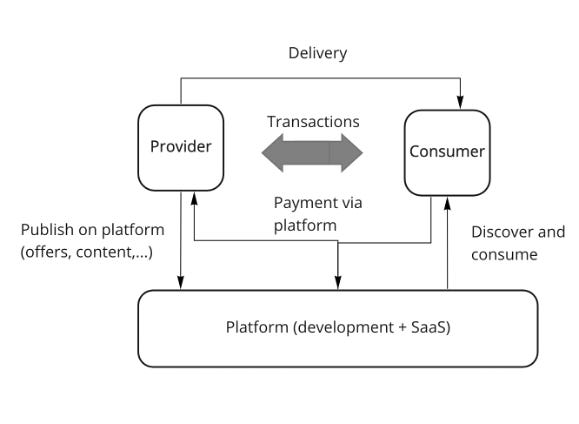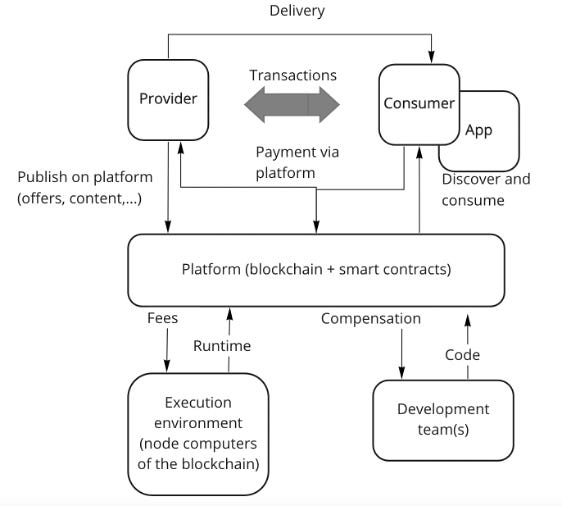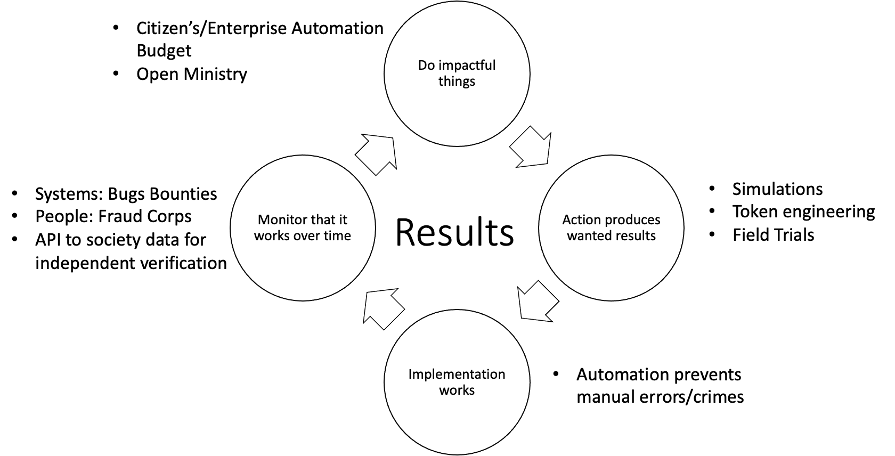Comparing. Comparing Key Characteristics of Models
Some features, modes of organizing work and characteristics are quite different between these two models and warrant individual comparisons.
Platforms
Much of the activities in future will be conducted through different platforms, so it makes sese to compare just this aspect separately.
On a very high level a platform can be seen as a service where the provider can publish their offer or post their content. Users use the discovery functions to select suitable offer and purchase it. The payment goes through the platform and the platform takes their fees from the payment. The service or product delivery happens outside of the platform.
In the centralised platform case, the orchestrator creates the service and operates it. This gives them unpresented power over participants. They see how different brand categories evolve, who are the successful sellers and which customers use the platform most (so called whales). Providers are typically prevented from having this information.
The platform operator can among others:
Push some providers offer down so that very few customers find it
Decide to offer their own white label products that compete in the very profitable categories and place this offer to the top of discovery results. Unprofitable categories can be left to “partners”
Show own ads on the service to the very high margin customers
Unilaterally change own profit margins
A decentralised case the power structure is quite different. The service for customers is the same, but the division of power and rewards is quite different.
Typically, a single development team initially develops the first version of the platform. The core of the platform is a set of automated scripts (smart contracts) that run on the selected blockchain platform. Once the code has been deployed, it runs independently on the computers that the blockchain “miners” make available.
The offers and purchases are publicly listed on the chain and the core logic runs independently on the chain as well.
This setup requires no employees and the interfaces are publicly available for anyone to create a client application that uses this content. Normally the client app is used for discovery of so that users find the relevant content. Wallet functionality needed for payment can be in this 3rd party app or some existing wallet app may be integrated.
This means that the single platform functionality is split into multiple parts. One set of teams develops the platform code further, another set of parties run the nodes where the code executes and different teams develop user interfaces and algorithms on top of the blockchain data and code. Often the platform sets up a fund or non-profit association that gets a small percentage of revenue. This is used for further development and for grants so that new development teams can join the project.
This means that the previous single control point is defused.
Adaptability
Organisations where humans are decisions makers tend to be rather flexible at least in principle. Managers have decision making power within their unit as long up to agreed level and bigger decisions are made in the the portfolio board . The shareholders meeting selects the board for the company and ultimately can decide a new direction for the company.
Many things naturally bog down this flexibility such as internal company politics, existing operating procedures that have lost their reason into the mist of time.
But current, centralised organisations work fundamentally differently than smart contract-based organisations. The saying in the web3 world is that “code is the law”. This means that:
Code on blockchains is hardware(-like)
Web3 systems are decentralised meaning that no single body has control over them but power it is distributed to participants. This also means that no single body can fix errors. Smart contracts are more hardware like than traditional software. Smart contracts are permanent and immutable once deployed to a blockchain
Software in contrasts is always changeable and in continuous deployment set ups fast to update. Project team can deploy a newer version but users do not have to switch over to it.
To survive in a changing world requires adaptability. How can smart contract-based ecosystems achieve this?
Many mechanisms exist for mitigations.
Cheapest is prevention.
Auditing. Direct errors are easiest to detect by having code audited and by having continuous bugs bounties. Ongoing attacks through a detected vulnerability can be stopped in a very coarse way by having an on/off toggle in the smart contracts of the project. They will stop all activities of part of the system and allow the community to take a time-out to figure what to do next.
Simulations. More complex features leading to unwanted outcomes can be simulated and smoked out through practices like token engineering as described earlier.
Copy with pride. Since source code from other projects is open sourced, it’s possible to read the code for successful ones and copy their approaches.
Adaptability in code. The code itself can be structured so that it is adaptable. A standard practice would be in the code of the smart contract to have one extra level of indirection. Whenever the smart contact needs to perform some key functionality, it calls a proxy function and this proxy in turn calls a delegate function. The proxy is written in a way that the delegate can be easily changed. This allows very fine-grained upgrades of the functionalities. For more see: https://medium.com/level-k/flexible-upgradability-for-smart-contracts-9778d80d1638 or https://blog.chain.link/upgradable-smart-contracts/
These approaches ensure a project survives the first six months out there.
Anti-fragility
Current systems like money have successfully evolved over millennia from standard measures of barley through coins in precious metals then to paper money further to banks, contracts, insurance, property laws and finally to complex financial constructs like derivatives, warrants and whatnots. The evolution has not stopped with central banks now daydreaming of CBDCs.
It seems immutability of blockchains and decentralisation of smart contract-based projects are severely constrained at first. This presents a dilemma: to be flexible and immutable, decentralised with fast response times.
Composability of the web3 certainly allows a great deal of flexibility. New projects and ideas can quickly spring up and integrate seamlessly with the rest. Users can just pull their investments from less well working projects onto new ones.
For existing projects however this presents a problem as users don’t have much of switch-over costs. The solution seems to be strong focus on building a loyal user community.
(We discussed composability on the post on CBDCs, but as a reminder deployed smart contracts can be called by anyone (unless there is extra code to somehow limit this). This makes it possible to construct new services by using interfaces of existing projects as building blocks.
Smart contracts are also open to integration from outside of the blockchains. Anyone can create an app or integrate a physical device that sends transactions to any smart contract. The concept of an open ecosystem is baked into the nature of the system.)
Still the nature of web3 is that a single service may lose its momentum and replaced by a better one. On system level things get better but at the cost of individual and project losses. This phenomenon is called anti-fragility.
Anti-fragility was coined by Nassim Taleb and refers to ecosystems that are not only resilient against stressors but grow stronger when under pressure. Nature actually works this way. When we exercise, this creates stress to the body but increases muscle power and strength of bones over time. A common example of this is a city with many competing restaurants. Many restaurants will go under due to competitive environment, but the same environment forces all entrepreneurs to constantly look for ways to differentiate and come up with new types of recipes and concepts. The end result is a better overall restaurant scene in the city at the cost of failed restaurateur. The web3 world works similarly. For more see Nassim Taleb’s book Antifragile.
The programmable nature of web3 offers new opportunities for evolution that we have only seen the beginning of. For example by taking advantage of the fact that the token balances are publicly visible on the chain. A successor project can offer to the members of a failing project that they can move their token values over to a new project with some adjustment factor (1:1 or something else). This would allow a newer project with better governance or other organisation to swallow a failing one and members still to retain the investments they made in the previous one.
A variant of this is where a substantial part of members decides to fork over to a new project that suits them better. Usually after some kind of fundamental dispute.
Integrity
In the current model integrity is achieved on the highest level by a 4-year political cycle where voters change politicians when they are not satisfied with outcomes. And on the lower levels by police and the judicial system.
The role of media is to keep the decision makers in parliament and on municipal level in check. This system has been somewhat eroded as Internet has destroyed the traditional business model of media (so much free news and other information out there) and media has found a new business model in activism (opinions instead of strive for objectivity). The change is still ongoing making it difficult to predict outcomes. Politicians also get direct feedback from citizens via social media, although there is so much trolling and state-sponsored influence operations to add bias.
Law making is public and stakeholder groups are actively consulted when new legislation is brough forward. Calculations are performed in advance on the expected results but the formulas and background data on how the results were achieved are not public (at least in Finland). Different stakeholders present their own estimates.
As mentioned, police and the judiciary system ensure that laws are followed.
One challenge in current system is that no one has big incentives to actively maintain integrity. The legal system is complex and it is getting more complex all the time. Systems that are complex have loopholes and unintended consequences. People with most interest in finding loopholes and ways to game to system, are criminals becayse they can get rich through exploitation.
How to prevent that? We’ve covered a number of options shown in diagram below
Out of these, today bugs bounties, token engineering (with simulations) are in use on the decentralised side.
Let’s walk through the loop.
Proposals or a substantial part of the proposals needs to be crowdsourced from people as this prevents politicians from misusing the system for their own benefits. Mechanisms like Citizen’s Automation Budget and Open Ministry ensure that the worst failures get corrected and processes automated. This also leads to a better understanding for population on how laws are made and what inefficiencies they currently have.
Simulations are used to do preliminary checks of proposals. Token engineering is one of the simulation techniques used for looking what types of results various token-based incentive structures can cause. Ideas that seem to work on simulators are tried in small field trials to see whether people behave anything like the simulators assume.
Proposals that also work in field trials go for decision making and if approved, get implementation. Implementations ideally need to be automated. This because automations prevent manual errors or manual misuses of the laws. If there is requirement for private enterprises to do anything, a reference implementation is created as a showcase that the policy is implementable.
Even best implementations may have errors. It’s important to discover them as soon as possible Bugs bounties are a way for rewarding people who find loopholes and errors in existing policies and how they get implemented. Fraud Corps is a way of ensuring that the people in general are not too trusting and check before making monetary transactions.
Once something is made into a policy, constant monitoring is needed because over time habits and needs change and people start find creative ways to circumvent whatever they are supposed to do. When society makes available its data via an API, anyone can create their own dashboards and make their own analysis on how well the society is working. This is a way for citizens to constantly audit how well the public side is working.
Transparency
In the common blockchains, the transactions and hence economic activity in general are publicly visible to anyone.
As an analogue one can think of how satellites today are used to monitor the earth. Satellites cover the entire earth and can be used to track regions from where no data is available due to political or other reasons. Such things are for example to follow pollution levels and compare to what that nation has publicly signed to do in international treaties. Other examples are deforestation, economic activity like new construction projects, amount of snow in an area (to predict spring floods) etc.
Blockchain records the digital “aerial” image of what is happening just now with a complete time series of previous states. This can be used to see how decentralised finance is evolving, how crowdsourced physical services grow, how different voting models become popular and what are the participation rates etc. What you cannot see from blockchains is where geographically the action is as the public IP addresses are not stored nor do wallet addresses reveal any personal information.
Satellites also allow to zoom into details and follow specific topics like volcanoes, landslides, specific boats on their ocean journey etc. In analogous way blockchain can be used to zoom into a particular service to follow its developments.
Structurally web3 projects and blockchain offer a level of visibility that has not been possible before. This openness stems from the cultural background of its originators. An obvious fact is that code is open sourced. As the identities of developers are not necessarily known, people want to see the code to validate it themselves before using a particular service. In practice overwhelming majority do not, but some do and fame can be gained by discovering something like that). trusted and will have hard time acquiring funding. Analogous feature exists in retail. Most people buy from shops goods that are clearly marked as on sale, but most do not remember exactly what the price was last week. So the question is that why do not supermarkets simply lie about discounts to boost sales. The answer is that some people do and they are eager to point out any faul play. These individuals have even an own term - price vigilantes.
Another aspet relates to internal communications and onboarding new people.
Private companies organise themselves into hierarchies (top level, marketing, sales, development, delivery, field engineers, support etc.). Communications inside the organisation is between individuals or small lists of people who participate into current discussion. Managers mail each other and agree things, bigger ones done in closed portfolio boards etc. When a new person enters – irrespective of rank - they do not have access to any of the old emails. What they get instead is a badly organised Intranet with outdated information. Not quite so bleak situation as messaging platforms where information flows across units and hierarchies are starting to become part of corporate life, sometimes still deteriorating into platforms of meaningless praise or places of cultural wars it seems (this seems to have happened since I left the big corp life).
In web3 the trend is to have discussions on instant messaging platforms (Discord seems to be the flavor of the month). When a new member enters and accepts the terms of the project, they get access to all of the past topics. This is a little bit like a new employee getting access to all of the emails a company has ever exchanged inside. Projects will create some “start here” discussion threads and may hire some people to mentor new members through the thick of it. Information is still badly organised and mostly outdated, but at least it is not hidden. This seems to be the natural state of human communications.
The more things change, the more they stay the same. Usenet news is one of the older Internet services and predates the web quite a bit being conceived 1979 by Tom Truscott and Jim Ellis. It was a place of open communications globally and some companies - including one where I worked - used an internal usenet service as discussion media where you can ask anything and people who had know-how or had been in similar project, shared their case materials. Back in the day one of the great features was that all materials were stored on your machine and you can search for relevant stuff at customer site even when you had no Internet connection. Later replaced with less functional tools for imaginary cost savings. Modern instant messaging platforms are nothing more than the same concept with a different name.



